Hi borninthefifties,
That looks like a fun build with those massive heat sinks. Can you share what other components you installed? What speakers do you use with this amp? Besides the small media player, what other sources do you intend to use with this amp?
Hi Rhing.
I have upgraded the tank capacitor to 50v 2200uf
The input/blockers are DNA 1.8uFPolypropylene film capacitors, (I work in the comms industry, and these are cut outs from master telephone sockets), they seem to give a good tone to my ear anyway!?
Everything else is 'chinese' stock. Dumped the volume control and input jack. Phonos are Nuetrik.
Tend to pull a lot of bits and pieces from redundant comms equipment.
Speakers are KEF Cadenza 1024's KEF Coda, Gale Monitors, Roth Audio Oli 10's and 20's.
Homemade Passive pre
Marrantz CD Player 6003.
Windows music server, feeding Soundblaster X-Fi HD
Got probably 25 - 30 homemade amps, just not good at making cases!
I purchased another $5 TDA7297 and this time, I did the following:
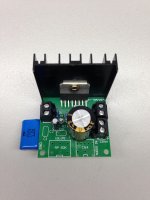
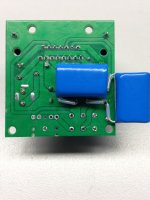
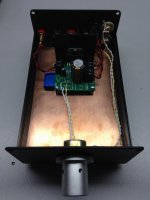
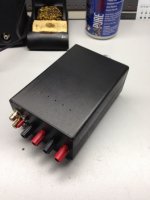
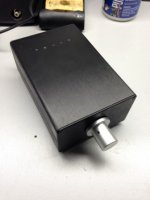
I have to say that I am growing partial to these Class AB chip amps. The external components are minimal and the amp has plenty of power and headroom to drive my efficient Klipsch Forte II speakers to ear-splitting levels. In comparison to my previous TDA7297 using the 1.0uF/50V Black Gate N non-polar electrolytic caps at the inputs, this amp has a significant edge with detail and scale of the soundstage. The separation is very good and the imaging is very focused.
I thought using the 470uF/25V Nichicon KZ Muse cap might result in a decrease of bass weight and definition, but it hasn't diminished. In fact, the amp seems to have a bit more attack with a sustained decay. This coupled with the warm tonality really gives this amp a tube-like flavor. This amp is not flabby, bloated or overly lush, but very musical and engaging--maybe more engaging than the TPA3116 Class D amps I've been playing with.
That said, I just received "The Weiner" TPA3118 Class D amp from gmarsh's group buy on diyAudio.com. I'll have to compare it to this amp, but at the end of the day, I am leaning toward this amp versus the TPA311x house sound.
The beauty of this amp lies in its simplicity and economics to come up with a great-sounding, simple integrated amp. I don't have to be concerned with output filters, switching frequencies, power-on pops and so on. This is probably the best amp for someone who is just starting on the path of DIY audio. One caveat is that the maximum output with reasonable distortion is around 8-10 watts, so it might not be a great match with less efficient speakers.
Now I have to shop for a TDA7297 IC from Mouser as Destroyer OS recommends. My buddy across the country has a similar set-up and he said the Mouser-sourced TDA7297 sounds much better than the stock IC that came with his Chinese-built amp.
- Removed the polarity protection diode and replaced it with a 23AWG solid core Copper wire.
- Removed the small 100nF ceramic cap.
- Replaced the stock 2,200uF/25V electrolytic cap with a 470uF/35V Nichicon KZ Muse cap.
- Replaced the stock .22uF metallized film caps with Radio Shack 1.0uF/250V metallized Polyester film caps (1.0uF 250V 10% Metal-film Capacitor - Radioshack).
- Replaced the stock 50k volume pot with a 21-step 50k log taper SMD resistor stepped attenuator.
- Replaced the stock terminal blocks with Weidmuller terminal blocks.
- I put this amp inside the same enclosure I had used with a previous TDA7297 amp with .22uF Mundorf Supreme film caps and an Alps Blue Velvet volume pot.





I have to say that I am growing partial to these Class AB chip amps. The external components are minimal and the amp has plenty of power and headroom to drive my efficient Klipsch Forte II speakers to ear-splitting levels. In comparison to my previous TDA7297 using the 1.0uF/50V Black Gate N non-polar electrolytic caps at the inputs, this amp has a significant edge with detail and scale of the soundstage. The separation is very good and the imaging is very focused.
I thought using the 470uF/25V Nichicon KZ Muse cap might result in a decrease of bass weight and definition, but it hasn't diminished. In fact, the amp seems to have a bit more attack with a sustained decay. This coupled with the warm tonality really gives this amp a tube-like flavor. This amp is not flabby, bloated or overly lush, but very musical and engaging--maybe more engaging than the TPA3116 Class D amps I've been playing with.
That said, I just received "The Weiner" TPA3118 Class D amp from gmarsh's group buy on diyAudio.com. I'll have to compare it to this amp, but at the end of the day, I am leaning toward this amp versus the TPA311x house sound.
The beauty of this amp lies in its simplicity and economics to come up with a great-sounding, simple integrated amp. I don't have to be concerned with output filters, switching frequencies, power-on pops and so on. This is probably the best amp for someone who is just starting on the path of DIY audio. One caveat is that the maximum output with reasonable distortion is around 8-10 watts, so it might not be a great match with less efficient speakers.
Now I have to shop for a TDA7297 IC from Mouser as Destroyer OS recommends. My buddy across the country has a similar set-up and he said the Mouser-sourced TDA7297 sounds much better than the stock IC that came with his Chinese-built amp.
Last edited:
[*]Removed the small 100nF ceramic cap.
Did you replace that with something else or just leave the circuit open where the 100nF used to be?
I bought two of these little guys from ebay, but still haven't had a chance to hear how they sound. One the first one, I accidentally wired the input power polarity in reverse. And that was after replacing the diode with a wire. D'oh! I had some extra capacitors between the electrical input and the amp, I'm lucky they didn't explode. They did get hot and start smoking.
So then, on the next board, I did all the mods, and quadruple-checked that I had the power input correct. The amp's LED turns on, but I get no sound. And the drivers on my speakers get "sucked in" presumably to their max excursion. So am I right to guess that there is a ton of DC on the output?
Any hope of salvaging either of these? Or, given that they were only $3 and $4, should I just chuck 'em and start over?
I'm thinking about plopping down $20 for the "5pcs kits" available on ebay, mainly just for the PCBs and heatsinks, as I'll put virtually all new components on the board, including the tda7297, as I'm sitting on a "true" one I bought from Mouser or DigiKey.
Another option is to just point-to-point wire this up, given how simple it is.
...Or, is there any chance of the group buy PCBs that have been floated in this thread seeing the light of day?
With the $3 ones it is best to ignore the polarity markings for input voltage and determine the polarity yourself before doing any mods or plugging it in to anything else. I learned this the hard way; it fried my miniDSP. On both my amps, the polarity markings were inversed.
I'd love to experiment with these more, but that'll have to wait till I get a few other projects done around the house. I agree that point-to-point should be easy enough to do...
I'd love to experiment with these more, but that'll have to wait till I get a few other projects done around the house. I agree that point-to-point should be easy enough to do...
Too bad you can't get these anymore
5pcs TDA7297 IC Digital Amplifier Board DIY Kit 15W 15W | eBay
I have 4 left, and am waiting on "real" chips from Digikey.
The DC inputs are labeled wrong. I check everything with DMM before
powering up.
5pcs TDA7297 IC Digital Amplifier Board DIY Kit 15W 15W | eBay
I have 4 left, and am waiting on "real" chips from Digikey.
The DC inputs are labeled wrong. I check everything with DMM before
powering up.
I have purchased all of my TDA7297 amps from eBay seller homemart.usa. The boards are properly labeled and I've never received a defective unit. They cost a couple dollars more, but you get what you pay for. The jury is still out on whether the TDA7297 ICs are equal to the ones you can get from Digikey or Mouser, but the amp sounds great in my system.
The small 100nF ceramic cap on the amp is a bypass to the larger 2.200uF/25V electrolytic cap on the DC power supply. Removing it removed ringing at high frequencies, which is funny, because its purpose is to prevent it. Using a Panasonic FM or Nichicon KZ electrolytic cap in place of the stock cap works well.
I agree a group buy PCB is overdue, but I think point-to-point with a good perforated board will work, and you can use any 1uF film input caps. I would start with either the Radio Shack MKT, Wima MKP10 or the Dayton Audio metallized Polypropylene film caps from Parts Express.
The small 100nF ceramic cap on the amp is a bypass to the larger 2.200uF/25V electrolytic cap on the DC power supply. Removing it removed ringing at high frequencies, which is funny, because its purpose is to prevent it. Using a Panasonic FM or Nichicon KZ electrolytic cap in place of the stock cap works well.
I agree a group buy PCB is overdue, but I think point-to-point with a good perforated board will work, and you can use any 1uF film input caps. I would start with either the Radio Shack MKT, Wima MKP10 or the Dayton Audio metallized Polypropylene film caps from Parts Express.
Too bad you can't get these anymore
5pcs TDA7297 IC Digital Amplifier Board DIY Kit 15W 15W | eBay
I have 4 left, and am waiting on "real" chips from Digikey.
The DC inputs are labeled wrong. I check everything with DMM before
powering up.
I just bought this 5pcs kit from ebay. Listing title "5pcs TDA7297 2*15W Audio Amplifier Board 15W +15W Dual-Channel DIY New AC/DC", seller e-worldseller. $22.50.
It's kind of funny, I had read all the advice here to look out for mis-labeled DC inputs. And I did indeed check with my DMM, and still managed to screw it up. Pure brain fart, that's all there is to it.
Ironically, my $2.76 one was labeled correctly, and my "premium" $4.39 one was mislabeled.
The small 100nF ceramic cap on the amp is a bypass to the larger 2.200uF/25V electrolytic cap on the DC power supply. Removing it removed ringing at high frequencies, which is funny, because its purpose is to prevent it. Using a Panasonic FM or Nichicon KZ electrolytic cap in place of the stock cap works well.
Interesting. I guess if you don't have the ringing (rhinging? ha!) nothing to worry about. I wonder if a better/different cap in that spot would have any positive effect?
I agree a group buy PCB is overdue, but I think point-to-point with a good perforated board will work, and you can use any 1uF film input caps. I would start with either the Radio Shack MKT, Wima MKP10 or the Dayton Audio metallized Polypropylene film caps from Parts Express.
Those film input caps are just for DC-blocking, right? Rhing, I'm surprised you haven't tried your Cinemags in place of the capacitors yet!
...
[*]Removed the small 100nF ceramic cap.
....
Déjà vu
"
You have to have hf [high frequency] ps [power supply] bypassing. Solder a X7R, 100n, 100V with as short leads as possible on the chip pins as close as possible to the package.
Nothing large or far away can bypass at high frequencies because the package inductance and the trace inductance (respectively) become so large they take the hf bypass cap 'out of the circuit.'
Cheers,
Jeff
"
http://www.diyaudio.com/forums/chip-amps/231988-what-heck-its-less-than-lunch-43.html#post4217084
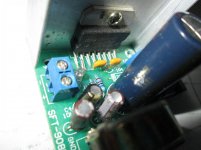
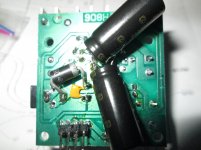
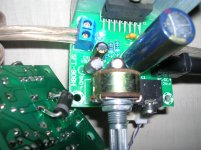
http://www.diyaudio.com/forums/chip-amps/231988-what-heck-its-less-than-lunch-40.html#post4111594
Last edited:
Interesting. I guess if you don't have the ringing (rhinging? ha!) nothing to worry about. I wonder if a better/different cap in that spot would have any positive effect?
... Those film input caps are just for DC-blocking, right? Rhing, I'm surprised you haven't tried your Cinemags in place of the capacitors yet!
I don't hear any ringing and my friends who have done the same mod have had the same experience. I've tried Panasonic FM and Nichicon KZ Muse caps so far, and the amp works well with these. I'm tempted to also try out a 1,000uF Panasonic SEPF OSCON in the position as well, but the other caps are fine.
The input caps do establish the corner frequency of the high pass input filter. As you said, they also serve as DC blockers. If you have a source component that has output coupling caps, you don't need these for DC blocking purposes.
Using the ST Micro-recommended .22uF caps on the inputs cut the lower octaves out, and you get a bass roll-off between 50-60Hz. Installing 1uF caps as I've done with the Black Gate N non-polar electrolytic caps or the Radio Shack MKT caps allows the amp to go much deeper. The TDA7297 amp goes just as deep at my TPA3116 amps and Dynakit Stereo 35 6BQ5/EL84 P-P amp. I am not sure why ST Micro recommends .22uF input caps.
My only reason for using the CineMags on the TPA3116 was to take advantage of the differential inputs and balanced signal processing for better noise rejection and improved sonics, which is what I obtained. With the TDA7297 single ended inputs, there really is no reason to use the transformers unless I have a ground hum issue or noise issue, which I don't. The TDA7297 amp is just as quiet as the TPA3116 with the CineMags, and a lot simpler and cheaper to make great sound. To my ears the TDA7297 does a better job at reproducing attack and decay of notes than the TPA3116 amp. The decay is more sustained and natural. The sound has greater presence as well.
Pardon my noob question but how are you calculating the corner frequency and what values are you using?Using the ST Micro-recommended .22uF caps on the inputs cut the lower octaves out, and you get a bass roll-off between 50-60Hz. Installing 1uF caps as I've done with the Black Gate N non-polar electrolytic caps or the Radio Shack MKT caps allows the amp to go much deeper. The TDA7297 amp goes just as deep at my TPA3116 amps and Dynakit Stereo 35 6BQ5/EL84 P-P amp. I am not sure why ST Micro recommends .22uF input caps.
Hi rhing, Is there a good source for the SMD resistor stepped attenuator you used?
I bought mine from eBay seller lasercollection.
Pardon my noob question but how are you calculating the corner frequency and what values are you using?
As mboxler pointed out, I am really extrapolating the corner frequency based on the frequency response curve and increasing the capacitance over 4x to reduce cut-off below 20Hz. fc = 1/(2πRC) is typically used for calculating this, where in this case R is the input impedance of the amplifier (ohms) and C is the input capacitance (Farads).
There is something wrong when a Starbucks and muffin costs more than something like this...
Yep! You're eating the wrong thing!
I just received mine, in stock form it actually sounds pretty good. . I am using it with a Sony CD player and a pair of Fostex FE103EN bass reflex speakers. After burn in I will remove the diode, change out the caps, volume control and install it into a box. Lots of fun for only $6.44 or a lunch.
7297???
Rich,
You've inspired me (here and on Klipsch forum)to get my TDA7297s out of mothballs. I'd gotten lazy and have been listening to 2-channel via my AVR. Since acquiring a Pono player, I'm again motivated to improve SQ for music, while leaving the AVR to handle movies and TV.
Please check for PM through Klipsch forum.
Thanks,
Neil
I have purchased all of my TDA7297 amps from eBay seller homemart.usa. The boards are properly labeled and I've never received a defective unit. They cost a couple dollars more, but you get what you pay for. The jury is still out on whether the TDA7297 ICs are equal to the ones you can get from Digikey or Mouser, but the amp sounds great in my system.
The small 100nF ceramic cap on the amp is a bypass to the larger 2.200uF/25V electrolytic cap on the DC power supply. Removing it removed ringing at high frequencies, which is funny, because its purpose is to prevent it. Using a Panasonic FM or Nichicon KZ electrolytic cap in place of the stock cap works well.
I agree a group buy PCB is overdue, but I think point-to-point with a good perforated board will work, and you can use any 1uF film input caps. I would start with either the Radio Shack MKT, Wima MKP10 or the Dayton Audio metallized Polypropylene film caps from Parts Express.
Rich,
You've inspired me (here and on Klipsch forum)to get my TDA7297s out of mothballs. I'd gotten lazy and have been listening to 2-channel via my AVR. Since acquiring a Pono player, I'm again motivated to improve SQ for music, while leaving the AVR to handle movies and TV.
Please check for PM through Klipsch forum.
Thanks,
Neil
I have to credit Destroyer OS on this forum for convincing me to try the higher 1uF capacitance on the inputs. I thought the ST Micro TDA7297 data sheet's frequency response curve was the best the amp was able to deliver., and moth balled my TDA7297 amp too However, increasing the capacitance really improved the bass response and the lower midrange as well. A friend of mine and I did a head-to-head comparison between a few of my TPA311x amps and the TDA7297, and we both preferred the TDA7297 for its tonality, presence and huge soundstage. For the price of the amp and modest parts upgrades, this is one of the best kept audio secrets for low powered amps.
- Home
- Amplifiers
- Chip Amps
- What the heck? It's less than lunch!